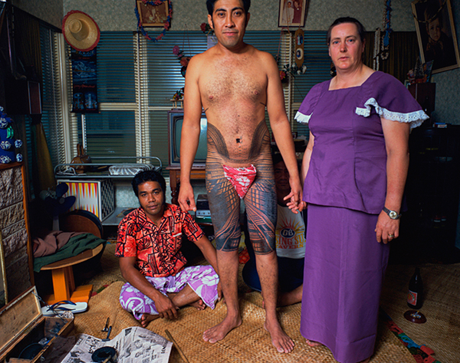
Mark Adams has been documenting the diaspora of the Samoan people for more than a quarter century. In 1972, photographing on assignment for an Australian magazine, Adams was introduced to Sulu'ape Paulo, a traditional Samoan tattoo master or Tufuga ta tatau. He gained access to the sessions of the Pe'a, a ritual in which men are gradually covered with tatau, a dense, dark tattoo pattern stretching between the waist and the knees. The patterns vary slightly depending on the social status of the bearer. The traditional tatau is usually completed over 10 days; it is extremely painful and not without risk of health complications.
Reaching back 2,000 years, the Pe'a ceremony initiates young men into society and confirms their social status and their responsibilities to the community. The tatau engraves the cosmology of Samoans right into their skin. The triangular form in the small of the back, for instance, symbolizes a flying fox that in turn represents the protective forces of nature. It is a pe'a, one of the largest bats in the world, from which the ceremony derives its name and that is currently on the list of species threatened by extinction.
Some aspects of the Pe'a correspond to the potlatch ceremonies of the North American West Coast native peoples and, like the potlatch, the Pe'a was suppressed by missionaries and colonial authorities. Among migrant Samoan communities, Pe'a is today performed often not as a rite of passage in the traditional sense, but rather as evidence of connection to the Samoan culture and tradition.
The completion of the ceremony, taking place over weekends, may take in this case several months or even years. In recent years, Samoan tattoo performed by traditional masters migrated beyond boundaries of Samoan culture to become a global phenomenon. Working with the Westerners, however, the best internationally known Tufuga ta tatau, Sulu'ape Paulo, did not stick rigorously to traditional patterns, molding them instead into expressions of his personal artistic explorations.
Focusing on the inconspicuous
Adams is today New Zealand's foremost documentary photographer, and his exhibit, "Tatau: Samoan Tattooing and Global Culture," is on display until Sept. 30, 2009, at the UBC Museum of Anthropology.
In an interview with The Tyee, Adams said that when attending art school, he was fascinated by works of Irving Penn and Richard Avedon, but in his tatau photography there is little of Avedon's possessiveness or the elegantly structured composition of Penn's. His subject are not posed beyond the minimum forced by the technique of photography, they sort of accommodate a large format camera that Adams places in their living rooms and studios. The lighting is there simply to provide exposure. Adams does not intervene in the documented scene, yet he doesn't pretend that he is not a part of it.
The apparent simplicity of Adams' photographs could be misleading. The Tatau series illustrates layered relationships between the photographer and the subjects, the tatau master and the tattoo receiver, the Samoan and the Western cultures, the flesh and the soul, all of the above and the global voyeur represented in the room by the camera lens -- just to name a few.
Adams is an artist of many conflicting features. When he began his work on the tatau, he rejected visual anthropology and ethnography. He considered it an instrument of colonial empowerment and his own work being antithesis of that. Some decades later, his large format photographs cover the walls of the Museum of Anthropology. Adams quite likes it; he believes that the anthropology changed more than his photography.
Engaging history with an 8 x 10
Another interesting project of Adams is accessible at Auckland's Two Rooms Gallery website.
The landscape panoramas from the series Cook's Sites are in the words of the anthropologist Nicholas Thomas: "an engagement with the deep artful, bloody and inextricably complicated histories of colonialism in the Pacific." Adams travels to the sites where Cook landed in the South Pacific, often looking for the precise spots illustrated by Cook's companions, painters John Webber and William Hodges.
Adams' panoramas consist of a series of incredibly detailed prints made from 8 x10 plate camera negatives. Frames are not stitched together, sometimes not exactly aligned. They bring attention to the fact that the seamless spatial and temporal world is but a user's illusion produced by our minds burdened with streamlining the infinite universe of data into comprehensible but inevitable simplified reflection.
The golden standard
Adams considers his photography "conceptual up to a point." His photographs do well without excessive catalog essays or other critical intervention because of their rich narrative and documentary content. He does not strive for a universal ontological revelation. He is satisfied with telling or retelling the stories that benefit from his long attention span. He learns the history and the present of the Cook's landing sites. He pinpoints them, camps at them and revisits them while his photography slowly takes shape.
In other words, he abides by the documentary's golden standard, which I call the Cree Elder's Principle. In 1974, while being sworn in as a witness to the court, an elder Cree hunter said he couldn't swear to tell the truth, the whole truth, and nothing but the truth, but could only promise to tell what he knew.
Mark Adams knows things.
Related Tyee stories:
- Aboriginal Art Turned Inside Out (Gallery)
Conceptual artist Brian Jungen on 'Indian crafts,' Nike Town, glitz, pine beetles and more. A Tyee interview. - Exhibiting Conflicts
Whose truth gets told in today's museums? - Architecture of Hope Revisited (Photo Essay)
BC saw a flowering of innovative First Nations school design. What grows there now?
Read more: Photo Essays














Tyee Commenting Guidelines
Comments that violate guidelines risk being deleted, and violations may result in a temporary or permanent user ban. Maintain the spirit of good conversation to stay in the discussion.
*Please note The Tyee is not a forum for spreading misinformation about COVID-19, denying its existence or minimizing its risk to public health.
Do:
Do not: